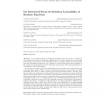Free Online Productivity Tools
i2Speak
i2Symbol
i2OCR
iTex2Img
iWeb2Print
iWeb2Shot
i2Type
iPdf2Split
iPdf2Merge
i2Bopomofo
i2Arabic
i2Style
i2Image
i2PDF
iLatex2Rtf
Sci2ools
ML
1998
ACM
1998
ACM
On Restricted-Focus-of-Attention Learnability of Boolean Functions
In the k-Restricted-Focus-of-Attention (k-RFA) model, only k of the n attributes of each example are revealed to the learner, although the set of visible attributes in each example is determined by the learner. While the k-RFA model is a natural extension of the PAC model, there are also significant differences. For example, it was previously known that learnability in this model is not characterized by the VC-dimension and that many PAC learning algorithms are not applicable in the k-RFA setting. In this paper we further explore the relationship between the PAC and k-RFA models, with several interesting results. First, we develop an information-theoretic characterization of k-RFA learnability upon which we build a general tool for proving hardness results. We then apply this and other new techniques for studying RFA learning to two particularly expressive function classes, k-decision-lists (k-DL) and k-TOP, the class of thresholds of parity functions in which each parity function ta...
Algorithm | K-rfa Model | Machine Learning | ML 1998 | Model |
| Added | 22 Dec 2010 |
| Updated | 22 Dec 2010 |
| Type | Journal |
| Year | 1998 |
| Where | ML |
| Authors | Andreas Birkendorf, Eli Dichterman, Jeffrey C. Jackson, Norbert Klasner, Hans-Ulrich Simon |
Comments (0)

